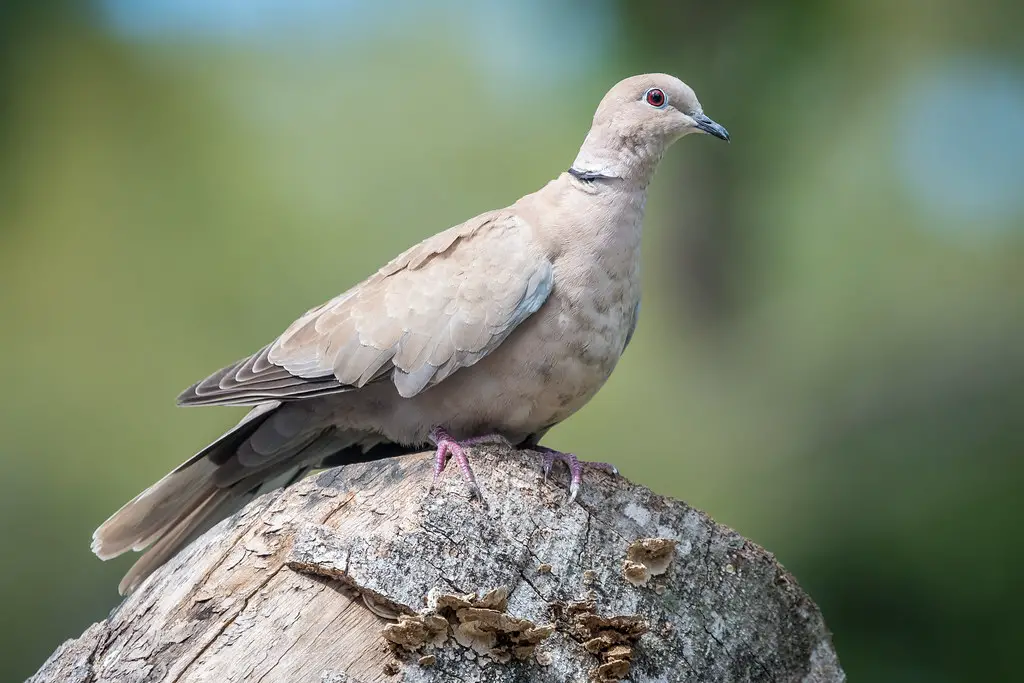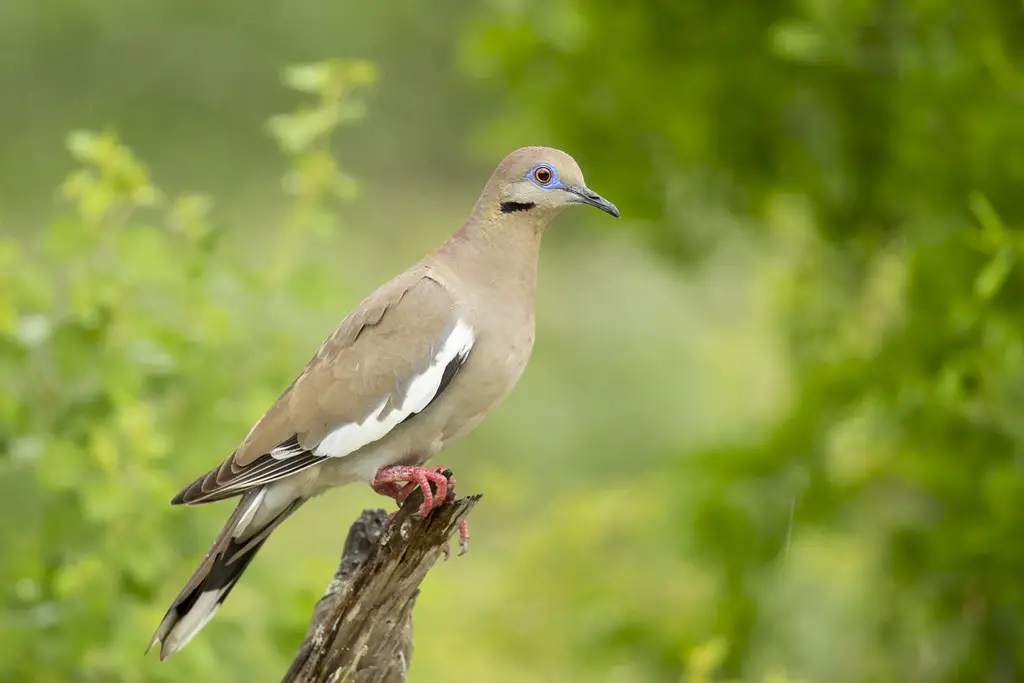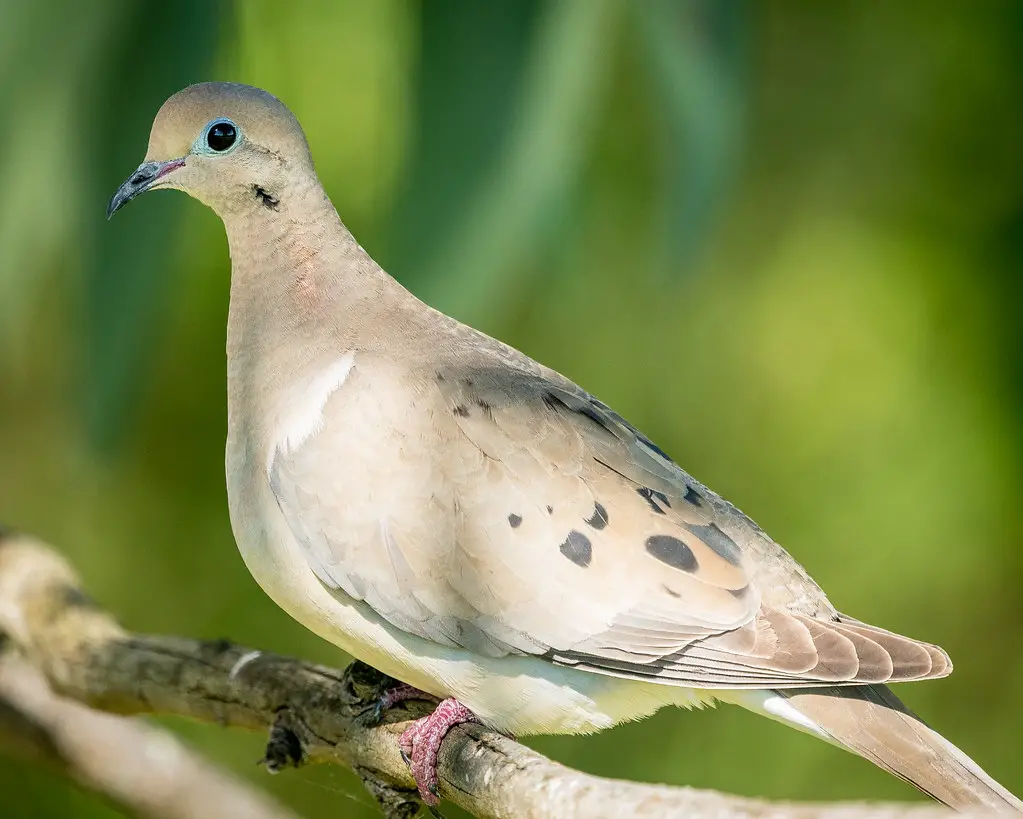Doves are a common sight in Michigan, and their gentle coos are a familiar sound to many. Whether you are a bird enthusiast or just someone who enjoys watching wildlife, the doves in Michigan are sure to capture your attention. In this blog post, we will explore the world of doves in Michigan, including their behavior, habitat, and unique characteristics. From mourning doves to white-winged doves, there is much to discover about these fascinating birds in the Great Lakes State. So, grab your binoculars and join us on a journey into the world of doves in Michigan.
Types of Doves in Michigan:
There are several species of doves in Michigan, each with its own unique features and traits. Some of the most common ones are:
- Mourning Dove
- Rock Pigeon
- Eurasian Collared-Dove
- White-winged Dove
Mourning Dove 
Image Source
- Scientific name: Zenaida macroura
- Lifespan: 2-5 years
- Size: 9-13 inches
- Native to: Southern Canada to central Mexico
The Mourning Dove is the most common dove species in Michigan. They are named for their distinctive mournful cooing call, which is a familiar sound in many suburban and rural areas. their cooing sound is often heard in the early morning and late evening hours. These birds are about 12 inches long with a wingspan of 17 inches. They have plump, round bodies, small heads, and long, tapered tails. The plumage of mourning doves is generally brownish-gray with black spots on the wings. They also have a distinctive black marks on their face below their eyes. Mourning doves are primarily seed-eaters, feeding on a variety of seeds from plants such as grasses, weeds, and grains. They are also known to eat insects and snails.
These birds are monogamous and form pairs during the breeding season. They build their nests on tree branches or other elevated surfaces using twigs, grass, and other materials. Females usually lay two eggs, and both parents take turns incubating them for about two weeks. After hatching, the young are fed a special type of milk called “crop milk” that is produced by the parents. The chicks fledge after about two weeks and become fully independent about a week later.
Mourning doves are popular game birds, and many people enjoy watching and feeding them in their backyards. They are also important for seed dispersal and play a role in maintaining the ecosystem.
Rock Pigeon

Image Source
- Scientific name: Columba livia
- Lifespan: 6 years
- Size: 11-13 inches
- Native to: Europe to North Africa and India, it now lives in wild or semi-wild conditions in cities all over the world, including most of North America
The Rock Pigeon is a medium-sized bird with a plump body and short neck. It has a grey head, neck, and chest, with iridescent feathers on its neck and wings. Its wings are marked with two black bars, and its eyes have a bright orange-red iris.
Rock Pigeons are found in cities and towns around the world, often living in close proximity to humans. They are known for their distinctive cooing call and their habit of perching on ledges, buildings, and other urban structures.
These pigeons are generally monogamous and form pairs during the breeding season. They build their nests in sheltered locations, such as on ledges or in building eaves. They lay one or two white eggs, which are incubated by both parents for around two weeks.
Rock Pigeons are considered pests by some people due to their tendency to roost and nest in urban areas, as well as their droppings, which can be unsightly and cause damage to buildings. However, they are also appreciated by many as a familiar and often charming sight in cities around the world.
Overall, the Rock Pigeon is a fascinating bird that has adapted well to life in urban environments. Its distinctive appearance and call, as well as its close association with humans, make it an important part of many urban ecosystems.
Rock Pigeons, also known as city pigeons, are a familiar sight in urban areas. They have adapted well to human environments and can often be found roosting on buildings and ledges. Rock pigeons have a varied diet, including seeds, grains, and human food scraps.
Eurasian Collared-Dove

Image Source
- Scientific name: Streptopelia decaocto
- Lifespan: 3 years
- Size: 12-14 inches
- Native to: Bay of Bengal region (India, Sri Lanka, Myanmar
The Eurasian Collared-Dove is a non-native species that was first introduced to North America in the 1980s. They are similar in appearance to the Mourning Dove but have a distinctive black collar around their neck. Eurasian Collared-Doves can be found in a variety of habitats, including suburban areas, farms, and woodlands.
Their feathers are a pale grey-brown color and it has a red-orange eye-ring. This dove is known for its soft, cooing call which is a common sound in many urban and suburban areas.
Originally from Asia and Europe, the Eurasian Collared-Dove was introduced to North America in the 1980s and has since become a common sight across much of the continent. They are often seen perched on power lines or rooftops and are known to form large flocks in urban areas.
Eurasian Collared-Doves are opportunistic feeders and will eat a variety of foods, including seeds, grains, and insects. They are often found in gardens and agricultural areas where they can forage for food.
When it comes to nesting, Eurasian Collared-Doves are known for their adaptability and will use a variety of structures as their nesting site, including trees, shrubs, and man-made structures like buildings and utility poles. Their nests are often made up of twigs, grasses, and other plant materials and are typically located in a protected area like a tree or bush.
Overall, the Eurasian Collared-Dove is a fascinating bird that has adapted well to living in urban and suburban environments. Its distinctive appearance and soft cooing call make it a common sight and sound in many parts of North America.
White-winged Dove

Image Source
- Scientific name: Zenaida asiatica
- Lifespan: 10-15 years
- Size: 11 in
- Native to: Southwestern United States through Mexico, Central America, and the Caribbean
The White-winged Dove is a rare visitor to Michigan. They are typically found in the southern United States and Mexico but occasionally make their way north.
It is a large dove, measuring about 11 inches long, with a wingspan of approximately 20 inches. These doves have a unique appearance, with a white patch on their wings that contrasts with their light brown body. They also have a distinctive blue eye ring and a long, pointed tail. Both males and females look similar, but males tend to have a more vibrant plumage during the breeding season.
White-winged Doves are primarily seed eaters, but they also consume fruits, insects, and small snails. They are known to be opportunistic feeders and will eat a wide variety of food depending on what is available.
During the breeding season, these birds form monogamous pairs and build their nests in trees, shrubs, or cacti. Females usually lay two eggs, and both parents take turns incubating them for about two weeks. The chicks fledge after about two weeks and become fully independent about a week later.
White-winged Doves are famous game birds, and their populations are closely monitored by wildlife management agencies. They are also appreciated by birdwatchers for their unique appearance and behavior. In some areas, they are considered a pest because they can cause damage to crops and gardens. Overall, White-winged Doves are an important part of the ecosystem and play a role in seed dispersal and pollination.
Best Places to Spot Doves in Michigan:
- Belle Isle Park, Detroit
- Kensington Metropark, Milford
- Muskegon State Park, Muskegon
- Warren Dunes State Park, Sawyer
Final Thoughts
Michigan is home to several species of doves that add to the natural beauty and diversity of the state. Mourning doves, rock doves, and Eurasian collared doves are among the common species found in Michigan. These birds are known for their soft cooing calls, graceful flights, and peaceful nature. While doves are sometimes hunted for sport or food, they also play an important role in the ecosystem as seed dispersers and pollinators. It is essential to conserve their habitats and protect them from threats such as habitat loss, climate change, and hunting. By appreciating and preserving the presence of doves in Michigan, we can ensure that future generations can also enjoy their peaceful presence and ecological contributions.
Frequently Asked Questions (FAQs)
What types of doves can be found in Michigan?
Michigan is home to a few species of doves, including mourning doves, rock pigeons, and Eurasian collared doves.
When is the best time to spot doves in Michigan?
Doves are most commonly seen in Michigan during the summer months, from May to August.
Where can I find doves in Michigan?
Doves can be found throughout Michigan, but are most commonly found in open areas such as fields, agricultural land, and suburban areas.
What should I bring with me when birdwatching for doves in Michigan?
When birdwatching for doves in Michigan, it is recommended to bring binoculars, a field guide to help with identification, appropriate clothing and footwear, sunscreen, and insect repellent.



![10 Beautiful Red Birds in New York [Images + IDs]](https://birdsology.com/wp-content/uploads/2023/03/14235697222_3abaaf211f_b-600x400.jpg)
![10 Species Of Hawks In Wyoming [Images + Ids]](https://birdsology.com/wp-content/uploads/2023/03/8387755006_54847516a2_b-600x400.jpg)
![13 Beautiful Red Birds in Florida [Images + IDs]](https://birdsology.com/wp-content/uploads/2023/03/45-600x400.jpg)
![11 Species Of Hawks In Kansas [Images + Ids]](https://birdsology.com/wp-content/uploads/2023/02/33575565298_3d78424d85_b-600x400.jpg)